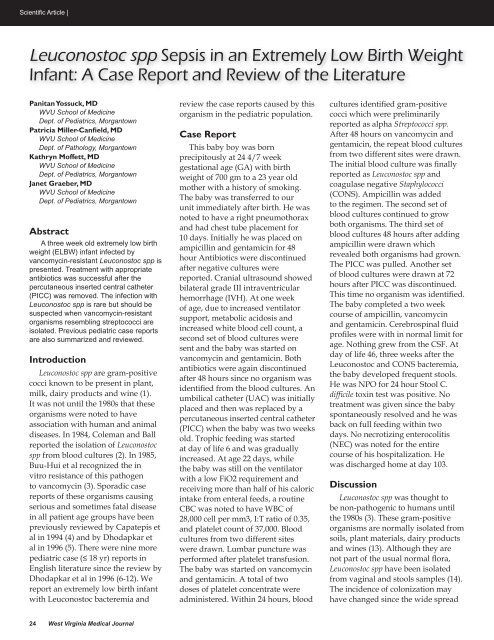September/October - West Virginia State Medical Association
September/October - West Virginia State Medical Association
September/October - West Virginia State Medical Association
- No tags were found...
Create successful ePaper yourself
Turn your PDF publications into a flip-book with our unique Google optimized e-Paper software.
Scientifi c Article |Leuconostoc spp Sepsis in an Extremely Low Birth WeightInfant: A Case Report and Review of the LiteraturePanitan Yossuck, MDWVU School of MedicineDept. of Pediatrics, MorgantownPatricia Miller-Canfield, MDWVU School of MedicineDept. of Pathology, MorgantownKathryn Moffett, MDWVU School of MedicineDept. of Pediatrics, MorgantownJanet Graeber, MDWVU School of MedicineDept. of Pediatrics, MorgantownAbstractA three week old extremely low birthweight (ELBW) infant infected byvancomycin-resistant Leuconostoc spp ispresented. Treatment with appropriateantibiotics was successful after thepercutaneous inserted central catheter(PICC) was removed. The infection withLeuconostoc spp is rare but should besuspected when vancomycin-resistantorganisms resembling streptococci areisolated. Previous pediatric case reportsare also summarized and reviewed.IntroductionLeuconostoc spp are gram-positivecocci known to be present in plant,milk, dairy products and wine (1).It was not until the 1980s that theseorganisms were noted to haveassociation with human and animaldiseases. In 1984, Coleman and Ballreported the isolation of Leuconostocspp from blood cultures (2). In 1985,Buu-Hui et al recognized the invitro resistance of this pathogento vancomycin (3). Sporadic casereports of these organisms causingserious and sometimes fatal diseasein all patient age groups have beenpreviously reviewed by Capatepis etal in 1994 (4) and by Dhodapkar etal in 1996 (5). There were nine morepediatric case (≤ 18 yr) reports inEnglish literature since the review byDhodapkar et al in 1996 (6-12). Wereport an extremely low birth infantwith Leuconostoc bacteremia andreview the case reports caused by thisorganism in the pediatric population.Case ReportThis baby boy was bornprecipitously at 24 4/7 weekgestational age (GA) with birthweight of 700 gm to a 23 year oldmother with a history of smoking.The baby was transferred to ourunit immediately after birth. He wasnoted to have a right pneumothoraxand had chest tube placement for10 days. Initially he was placed onampicillin and gentamicin for 48hour Antibiotics were discontinuedafter negative cultures werereported. Cranial ultrasound showedbilateral grade III intraventricularhemorrhage (IVH). At one weekof age, due to increased ventilatorsupport, metabolic acidosis andincreased white blood cell count, asecond set of blood cultures weresent and the baby was started onvancomycin and gentamicin. Bothantibiotics were again discontinuedafter 48 hours since no organism wasidentified from the blood cultures. Anumbilical catheter (UAC) was initiallyplaced and then was replaced by apercutaneous inserted central catheter(PICC) when the baby was two weeksold. Trophic feeding was startedat day of life 6 and was graduallyincreased. At age 22 days, whilethe baby was still on the ventilatorwith a low FiO2 requirement andreceiving more than half of his caloricintake from enteral feeds, a routineCBC was noted to have WBC of28,000 cell per mm3, I:T ratio of 0.35,and platelet count of 37,000. Bloodcultures from two different siteswere drawn. Lumbar puncture wasperformed after platelet transfusion.The baby was started on vancomycinand gentamicin. A total of twodoses of platelet concentrate wereadministered. Within 24 hours, bloodcultures identified gram-positivecocci which were preliminarilyreported as alpha Streptococci spp.After 48 hours on vancomycin andgentamicin, the repeat blood culturesfrom two different sites were drawn.The initial blood culture was finallyreported as Leuconostoc spp andcoagulase negative Staphylococci(CONS). Ampicillin was addedto the regimen. The second set ofblood cultures continued to growboth organisms. The third set ofblood cultures 48 hours after addingampicillin were drawn whichrevealed both organisms had grown.The PICC was pulled. Another setof blood cultures were drawn at 72hours after PICC was discontinued.This time no organism was identified.The baby completed a two weekcourse of ampicillin, vancomycinand gentamicin. Cerebrospinal fluidprofiles were with in normal limit forage. Nothing grew from the CSF. Atday of life 46, three weeks after theLeuconostoc and CONS bacteremia,the baby developed frequent stools.He was NPO for 24 hour Stool C.difficile toxin test was positive. Notreatment was given since the babyspontaneously resolved and he wasback on full feeding within twodays. No necrotizing enterocolitis(NEC) was noted for the entirecourse of his hospitalization. Hewas discharged home at day 103.DiscussionLeuconostoc spp was thought tobe non-pathogenic to humans untilthe 1980s (3). These gram-positiveorganisms are normally isolated fromsoils, plant materials, dairy productsand wines (13). Although they arenot part of the usual normal flora,Leuconostoc spp have been isolatedfrom vaginal and stools samples (14).The incidence of colonization mayhave changed since the wide spread24 <strong>West</strong> <strong>Virginia</strong> <strong>Medical</strong> Journal















